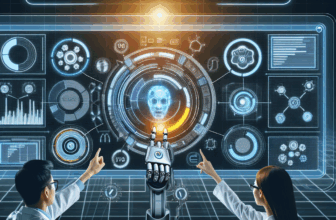Transforming Customer Experience: The Benefits of Predictive Customer Service Automation Through AI
Table of Contents
- Introduction
- Understanding Predictive Customer Service Automation
- The Impact of AI on Customer Service
- Benefits of Predictive Customer Service Automation
- Challenges and Considerations
- Real-Life Examples and Case Studies
- Future Trends in Predictive Customer Service
- Frequently Asked Questions (FAQ)
- Resources
- Conclusion
- Disclaimer
Introduction
In the fast-paced digital world, customer expectations are constantly evolving. As organizations strive to meet these ever-increasing demands, the push for enhanced customer experience (CX) has never been stronger. One of the most innovative and compelling advancements in this area is the integration of predictive customer service automation, powered by Artificial Intelligence (AI).
This article explores the transformative impact of predictive customer service automation, focusing on its benefits, how it functions, potential challenges, real-life applications, and future trends. Through in-depth analysis and case studies, we will illustrate how organizations leverage these advancements to improve customer interactions, satisfaction, and loyalty.
Understanding Predictive Customer Service Automation
Definition and Overview
Predictive customer service automation refers to the methods and technologies that use AI and machine learning algorithms to anticipate customer needs and automate responses before these needs escalate into issues. It encompasses a broad range of tools, including chatbots, recommendation engines, and automated ticketing systems, which work together to provide personalized experiences.
The power of predictive analytics lies in its ability to analyze vast amounts of data to find patterns and trends that human agents might miss. By efficiently predicting customer behaviors, organizations can tailor their approaches to meet individual and group needs in a timely and efficient manner.
How AI Enhances Predictive Analytics
AI enhances predictive analytics by employing algorithms that can process and analyze data at unprecedented speeds. Key areas in which AI improves predictive capabilities include:
-
Data Processing Speed: Traditional data analysis may take days, but AI systems can analyze vast datasets in seconds, providing businesses with immediate insights.
-
Pattern Recognition: Using machine learning, AI can identify complex patterns in data that are not obvious to human analysts, allowing organizations to pinpoint problems before they arise.
-
Real-time Analysis: AI allows businesses to react to changing consumer behaviors almost instantaneously, adjusting strategies and predictions on-the-fly.
-
Segmentation and Personalization: AI's advanced data processing capabilities enable deeper consumer segmentation, leading to more personalized and effective service delivery.
By integrating these capabilities, AI-driven predictive analytics equips companies with the means to proactively enhance the customer journey, leading to better outcomes and higher satisfaction rates.
The Impact of AI on Customer Service
Chatbots and Virtual Assistants
Chatbots and virtual assistants have become integral components of customer service strategies in recent years. Leveraging NLP (Natural Language Processing) and machine learning, they can interact with customers, answer queries, and guide them through various processes.
Evolution of Chatbots
The evolution of chatbots has been remarkable—they have moved from basic, rule-based systems to sophisticated AI-powered models capable of understanding context and emotional nuances. This evolution includes:
-
24/7 Availability: Unlike human agents, chatbots can provide round-the-clock service, addressing customer issues any time without requiring additional staffing.
-
Multitasking Capability: AI chatbots process inquiries simultaneously, vastly reducing wait times for customers.
-
Learning and Adaptation: Modern chatbots can learn from interactions, improving over time to provide better, more tailored responses.
Examples of Successful Implementations
Companies such as Sephora and H&M have successfully integrated chatbots into their customer service platforms. These chatbots handle various tasks, from booking appointments to providing personalized product recommendations based on customer queries. This not only enhances the user experience but also frees up human agents to address more complex requests.
Data-Driven Decision Making
AI has transformed customer service into a data-driven domain. By harnessing insights from customer data, companies can make informed decisions that lead to enhanced customer experiences.
Customer Insights and Feedback Analysis
Predictive customer service automation involves analyzing customer feedback and interactions to derive insights. These insights help in understanding customer preferences, pain points, and behavior patterns. Companies utilize customer feedback tools (NPS, CSAT, etc.) and analyze social media sentiments to gauge public perception effectively.
Optimizing Support Operations
AI can help organizations optimize support operations through performance monitoring. By analyzing tickets raised, resolution times, and agent performance metrics, businesses can identify areas for improvement, streamline workflows, and enhance customer support strategies.
Case Example: Zappos
Zappos employs extensive data analytics to power its customer service. Their approach is centered around understanding customer behaviors and trends through data analysis, enabling them to make proactive recommendations, which has significantly increased customer satisfaction and loyalty.
Benefits of Predictive Customer Service Automation
Increased Efficiency and Cost Reduction
One of the primary advantages of predictive customer service automation is increased efficiency and cost reduction.
Streamlined Processes
By automating routine queries and tasks, organizations can streamline processes that would otherwise consume valuable time and resources. This enables customer service representatives to focus on more complex and high-impact interactions that require human intervention.
Cost Reduction
With predictive analytics, organizations can reduce operational costs significantly. Fewer customer service representatives are needed to manage simple inquiries, which allows companies to operate leaner without sacrificing service quality.
Example: American Express
American Express utilizes AI-driven automation to handle a significant volume of customer interactions. This approach has not only led to faster response times but also reduced labor costs by minimizing the need for a larger service team.
Enhanced Customer Satisfaction
Predictive customer service automation leads to heightened customer satisfaction levels.
Proactive Problem Resolution
AI and predictive analytics enable organizations to anticipate and address customer issues before they escalate. By identifying potential problems through historical data patterns, companies can provide preemptive solutions, greatly enhancing customer satisfaction.
Personalization and Customer Engagement
Automation ensures that customers receive personalized service, which is increasingly important in fostering loyalty. AI systems can analyze customer behavior to deliver tailored recommendations and engage with customers on a deeper level.
Example: Netflix
Netflix leverages advanced predictive analytics to personalize viewer recommendations based on user preferences and viewing habits. This personalization enhances user satisfaction and has been pivotal in retaining subscribers.
Challenges and Considerations
Data Privacy and Security Concerns
With the significant increase in data collected through predictive customer service automation, Privacy and security concerns inevitably arise.
Regulatory Compliance
Organizations must navigate complex regulations such as GDPR and other data protection laws. Ensuring compliance while implementing AI-driven solutions is paramount for businesses to protect customer data.
Data Breaches
The risk of data breaches poses a significant threat. Cybersecurity measures must adapt to evolving technologies to safeguard sensitive customer information.
Resistance to Automation
Implementing automation can face resistance from employees and consumers alike.
Employee Concerns
Many employees fear that automation may lead to job losses. Organizations must address these fears through effective communication and training, emphasizing how automation can enhance their roles rather than replace them.
Customer Acceptance
While many customers appreciate the efficiency of AI, others may prefer human interaction, particularly in complex situations. Finding the right balance between automation and human service is crucial for customer satisfaction.
Real-Life Examples and Case Studies
Case Study: Starbucks
Starbucks has successfully integrated predictive analytics into its customer engagement strategy. The company uses data collected from its app to tailor recommendations, promotions, and even store layouts. This approach has led to increased sales and enhanced customer loyalty.
Case Study: Amazon
Amazon’s recommendation engine is a prime example of predictive customer service automation. By analyzing user behavior, purchase history, and preferences, Amazon can present personalized product suggestions. This not only improves sales conversion rates but also enhances the overall shopping experience.
Case Study: Salesforce
Salesforce provides predictive analytics tools enabling businesses to anticipate customer needs based on comprehensive data analysis. Organizations utilizing these tools have reported improved sales performance and customer satisfaction.
Future Trends in Predictive Customer Service
As AI technology continues to evolve, so too does the landscape of predictive customer service automation.
Advancements in AI
Improvements in AI technologies, such as neural networks and deep learning, will allow for even more sophisticated predictive capabilities. As these technologies develop, they will enable organizations to understand customer behaviors more deeply, improving the quality of service.
Hyper-Personalization
The future of customer service will likely see hyper-personalized experiences, where every interaction is tailored to individual preferences and needs. Companies must invest in the technology and insights required to achieve this level of personalization.
Integration with Other Technologies
Predictive analytics will increasingly integrate with other technologies, such as the Internet of Things (IoT), to create seamless and proactive customer experiences. For example, smart appliances can alert companies to potential issues before customers even notice them.
Frequently Asked Questions (FAQ)
Q1: What is predictive customer service automated?
A1: Predictive customer service automation uses AI and predictive analytics to anticipate customer needs and automate responses, improving service efficiency and quality.
Q2: What are some examples of predictive customer service tools?
A2: Examples include chatbots, virtual assistants, recommendation engines, and automated ticketing systems.
Q3: How does AI improve customer satisfaction?
A3: AI improves customer satisfaction through proactive problem resolution and personalized service, catering to individual customer needs.
Q4: What challenges do organizations face when implementing AI in customer service?
A4: Challenges include data privacy concerns, potential data breaches, employee resistance to automation, and customer preference for human interaction.
Resources
| Source | Description | Link |
|---|---|---|
| McKinsey & Company | Insights on AI in Customer Experience | McKinsey Insights |
| Harvard Business Review | Article on predictions for AI trends in business | HBR on AI |
| Gartner | Research on AI and customer service trends | Gartner Research |
| Salesforce | Blog on predictive analytics for business | Salesforce Blog |
| Forrester Research | Customer service and technology insights | Forrester Research |
Conclusion
As customer expectations continue to shift in an increasingly digital world, the adoption of predictive customer service automation powered by AI is becoming essential. This technology not only enhances customer service operations but also creates personalized experiences that foster loyalty and satisfaction.
By understanding the significant benefits and addressing the associated challenges, organizations can effectively leverage predictive customer service automation to transform their customer interactions. As the landscape evolves, staying informed and adaptable will be key to success in this dynamic environment.
Future trends indicate that AI technology will continue to advance, leading to even more sophisticated customer service solutions. Organizations must remain vigilant and ready to embrace these innovations to maintain their competitive edge.
Disclaimer
This article is produced by A.I. and is in Beta Testing. The information provided herein is intended for educational and informational purposes only. While efforts have been made to ensure the accuracy of the content, there may be errors or omissions. Readers should consider their own circumstances and seek professional advice where necessary.
This comprehensive article provides an overview of the transformative nature of predictive customer service automation through AI, examining its benefits, challenges, and future trends while offering tangible examples and actionable insights for businesses.










